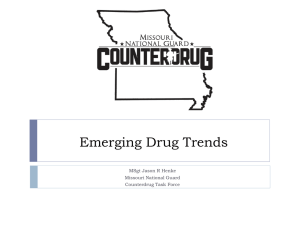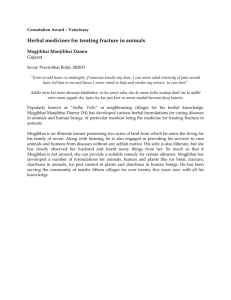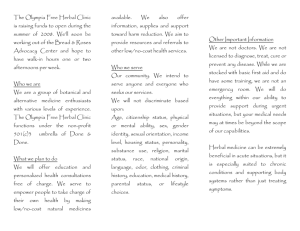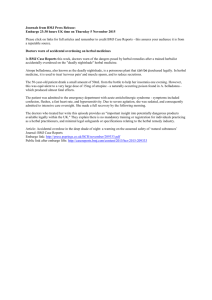Herbal Drugs – Medical and Surgical - e
advertisement
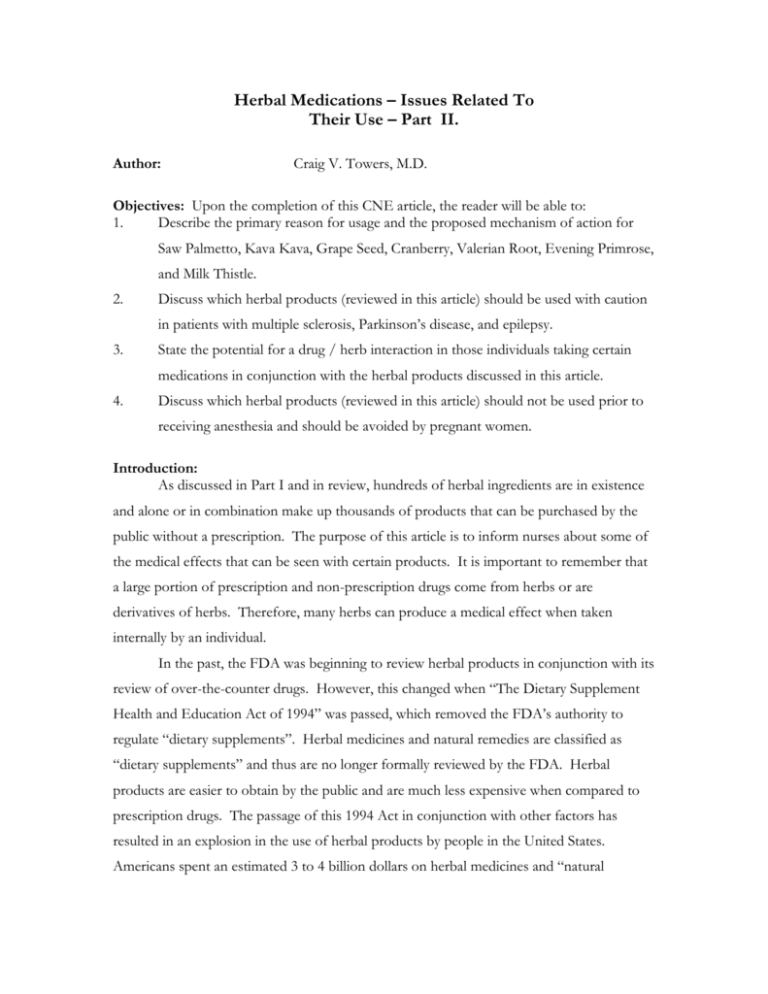
Herbal Medications – Issues Related To Their Use – Part II. Author: Craig V. Towers, M.D. Objectives: Upon the completion of this CNE article, the reader will be able to: 1. Describe the primary reason for usage and the proposed mechanism of action for Saw Palmetto, Kava Kava, Grape Seed, Cranberry, Valerian Root, Evening Primrose, and Milk Thistle. 2. Discuss which herbal products (reviewed in this article) should be used with caution in patients with multiple sclerosis, Parkinson’s disease, and epilepsy. 3. State the potential for a drug / herb interaction in those individuals taking certain medications in conjunction with the herbal products discussed in this article. 4. Discuss which herbal products (reviewed in this article) should not be used prior to receiving anesthesia and should be avoided by pregnant women. Introduction: As discussed in Part I and in review, hundreds of herbal ingredients are in existence and alone or in combination make up thousands of products that can be purchased by the public without a prescription. The purpose of this article is to inform nurses about some of the medical effects that can be seen with certain products. It is important to remember that a large portion of prescription and non-prescription drugs come from herbs or are derivatives of herbs. Therefore, many herbs can produce a medical effect when taken internally by an individual. In the past, the FDA was beginning to review herbal products in conjunction with its review of over-the-counter drugs. However, this changed when “The Dietary Supplement Health and Education Act of 1994” was passed, which removed the FDA’s authority to regulate “dietary supplements”. Herbal medicines and natural remedies are classified as “dietary supplements” and thus are no longer formally reviewed by the FDA. Herbal products are easier to obtain by the public and are much less expensive when compared to prescription drugs. The passage of this 1994 Act in conjunction with other factors has resulted in an explosion in the use of herbal products by people in the United States. Americans spent an estimated 3 to 4 billion dollars on herbal medicines and “natural remedies” in the year 2000, an increase of 10 fold from 1994. An estimated 80 million Americans used an herbal medication in the year 2000, excluding vitamins. As discussed in Part I, many of the herbal products have been studied (primarily in Europe or Asia), however, the majority of these studies are not randomized and placebo controlled. Extensive herbal medication usage has been ongoing in Europe for a long period of time compared to that of the United States. In the early 1980’s, Germany developed its “Commission E” (CE), which was a 24-member group of physicians, pharmacists, toxicologists, and pharmacologists that reviewed the literature on 380 herbs and published monographs on their conclusions. This review process occurred from 1983 to 1995. The World Health Organization (WHO) has also started to review some herbal medications and is creating monographs. Twenty such monographs have been completed with an additional 30 due by the end of 2001 to 2002. Currently, there are no ongoing reviews in the United States by an organized group of researchers. The information regarding the herbs in this article comes from Commission E and WHO reports as well as the most recent literature. Herbal Medication Usage in the United States: The top selling herbal medicines in the United States as of 2000 are seen in the table below: 1. Ginkgo Biloba 8. Grape Seed 2. St. John’s Wort 9. Cranberry 3. Ginseng 10. Valerian Root 4. Garlic 11. Evening Primrose 5. Echinacea 12. Bilberry 6. Saw Palmetto 13. Milk Thistle 7. Kava Kava 14. Ginger Numbers 1 through 5, 12 and 14 were discussed in Part I. The remaining 7 on this list will be discussed in this article. Saw Palmetto: Saw Palmetto is the number 6 selling herbal product in the United States. It has other names including Sabal, Cabbage Palm, American Dwarf Palm, and Shrub Palmetto. People primarily use this product for treating benign prostatic hypertrophy (BPH) and urination problems. Multiple studies have been performed to date, some are randomized, and a few are placebo controlled. The results vary because of differences in the preparation used, the duration of the study, and study design. However, overall, it appears that Saw Palmetto may improve urinary flow and urologic symptoms seen with BPH. It appears to have antiandrogenic properties by inhibiting the binding of dihydrotestosterone (DHT) to the prostate androgenic receptor. It also appears to be mildly anti-estrogenic and is antiinflammatory by inhibiting cyclooxygenase. Interaction with other drugs is unknown at this time; however, patients with hormone-dependant cancers should talk with their healthcare provider prior to using this herbal product because of its anti-androgenic and anti-estrogenic activity. It is also not recommended for use by pregnant women because of its anti-hormone effect Kava Kava: Kava Kava is another top ten selling herbal product in the United States. It has multiple other names including Tonga, Kew, Kawa, Awa, Intoxicating Pepper, Sakau, and Ava Pepper. This product is primarily used for treating stress, anxiety, and insomnia Multiple studies have been performed to date, some are randomized, and a few are placebo controlled. The majority of studies show that it is effective in treating anxiety. Its pharmacologic action appears to be mediated through kavalactones, which have a central muscle relaxation effect. The herb also has hypnotic / sedative effects and mild analgesic action. The potential for abuse or addiction is uncertain at this time. Potential concerns regarding this herbal product are use in patients with depression because of the potential for making the depression worse (and possibly suicidal). In addition, kava kava should be avoided or used with caution in conjunction with other sedating substances (because of an additive effect) like alcohol, other tranquilizers or sedatives (such as benzodiazepines, barbiturates, glutethimide, meprobamate, etc.), pain medications (such as morphine, meperidine, codeine, etc.), antihistamines (over-the-counter and prescription), anticholinergic drugs (such as atropine, scopolamine, etc.), and the herb valerian. Coma has been reported in a patient who used kava kava with alprazolam (a benzodiazepine-type drug). The use of this herb has also been reported to antagonize the effect of dopamine, and therefore, patients with Parkinson’s disease should not use this product. It is also felt that this herb should not be used prior to surgery because of the possibility for potentiating the anesthetic. Individuals who chronically consume large amounts of kava kava may develop a kava dermopathy, which is characterized as a yellowing of the skin with a scaly, flaky, rash. This reverses with the discontinuation of the herb. Pregnant women or nursing mothers should also avoid this herbal product. Grape Seed: Grape Seed extract is another top ten selling herbal product in the United States. Other names for this herb include Activin, Red Wine Extract, and oligomeric proanthocyanidins or OPC’s. Grape Seed extract is primarily used for treating circulation disorders, venous insufficiency, and nocturnal leg cramps. Very few studies have been performed to date and most are not randomized or placebo controlled. The proposed mechanism of action is the antioxidant effects of the proanthocyanidins, which potentially decrease LDL cholesterol and stabilize capillary walls (thereby decreasing permeability and hence edema). The use of this product probably stems from its relationship to wine and the potential cardiovascular benefits of limited to moderate wine consumption. At this time, knowledge regarding potential drug interactions is lacking as well as any potential problems in usage with other common medical disorders. In addition, no information exists regarding its use during pregnancy or lactation. Cranberry: Cranberry is also a top ten selling herbal product in the United States. Other names for this herb include Arandano, Moosebeere, and Mossberry. Cranberry is primarily used for treating urinary tract infections and as a urinary deodorizer. A few studies have been performed to date, but most are not randomized or placebo controlled. Most studies have not shown a benefit to using cranberry in treating an ongoing urinary tract infection. Some studies, however, have shown a benefit of cranberry in reducing the recurrence rate of urinary tract infections in those individuals prone to infection. The proposed mechanism of action is not completely understood. Cranberry is acidic, but it does not make the urine acidic nor does it have antibiotic action. There is an unidentified substance in cranberry that seems to interfere with the adherence of bacteria to the mucosal lining of the urinary tract and this factor may play a role in decreasing urinary tract infections in some individuals. At this time, knowledge regarding potential drug interactions is lacking as well as any potential problems in usage with other common medical disorders. In addition, no information exists regarding its use during pregnancy or lactation. Valerian Root: Valerian Root is the number 10 selling herbal product in the United States. It has multiple other names including Vandal Root, All-heal, Setwall, Amantilla, Capon’s Tail, Heliotrope, and Baldrian. This product is primarily used for treating stress, anxiety, and insomnia Multiple studies have been performed to date, some are randomized, and a few are placebo controlled. The majority of studies show that it is effective as a sedative in treating insomnia. Its pharmacologic action is not completely understood, but appears to be mediated through a combination of compounds found within the herb. The effects of the herb are multiple including hypnotic-sedative, antidepressant, anticonvulsant, and antispasmodic. It also appears that dependence to valerian occurs and that a benzodiazepine-like withdrawal will develop if the herb is suddenly stopped after chronic usage. Therefore, if an individual is to stop taking valerian after chronic usage, they should be tapered over several weeks. Potential concerns regarding this herbal product primarily include its usage with other sedating drugs. Therefore, valerian should be avoided or used with caution in conjunction with other sedating drugs (because of an additive effect) like alcohol, other tranquilizers or sedatives (such as benzodiazepines, barbiturates, glutethimide, meprobamate, etc.), pain medications (such as morphine, meperidine, codeine, etc.), antihistamines (overthe-counter and prescription), anticholinergic drugs (such as atropine, scopolamine, etc.), and the herb kava kava. Though kava kava is not recommended for usage by people with depression, valerian is actually the opposite and has been used in treating some mood disorders including depression and attention deficit hyperactivity disorder. However, it is also felt that this herb should not be used prior to surgery because of the possibility for potentiating the anesthetic (similar to kava kava). At this time, knowledge is lacking regarding potential problems in usage with other common medical disorders. Pregnant women or nursing mothers should also avoid this herbal product. Evening Primrose: Evening Primrose is one of the top 20 sold in the United States. It has several other names including Scabish, SunDrop, Fever Plant, King’s Cureall, and Night Willow-herb. It is primarily used for treating symptoms of premenstrual syndrome (PMS), mastalgia, and hot flashes. Several studies have been performed, however, very few are randomized or placebo controlled. In addition, the majority of studies have not shown this herb to be effective in minimizing the symptoms of PMS, when compared to placebo. It may however, have some benefit in treating mastalgia. Its pharmacologic action is uncertain, however, one of its compounds is converted to prostaglandin E-1 (PGE-1). PGE-1 is a substance that can have an effect in many different places in the human body including dilation of the bronchial tree and dilation of blood vessels, decreasing the production of gastric acid, increasing the production of mucus in the stomach and intestines, and causing uterine contractions. The amount of PGE-1 produced by the human body (as evening primrose is metabolized) is uncertain. Potential concerns regarding this herbal product are usage in patients with epilepsy or seizure disorders because of case reports suggesting that it can lower the seizure threshold. In addition, seizures have been reported to occur in patients with schizophrenia being treated with phenothiazines when this herb was taken. Therefore, individuals with these disorders should not use evening primrose. Because a portion of this herb is converted to PGE-1, usage with other available PGE-1 drugs (such as alprostadil and misoprostol) should be avoided or monitored closely because of the potential for a duplicate action. Finally, because of this PGE-1 conversion, pregnant women should avoid this herb, especially if there is a risk for premature labor or miscarriage (because of the potential for uterine contractions). Milk Thistle: Milk thistle is also one of the top 20 herbal products sold in the United States. It has several other names including Holy Thistle, Lady’s Thistle, St. Mary Thistle, Marian Thistle, and Silymarin. It is primarily used for treating dyspepsia and disorders of the liver (alcohol induced, drug induced, or hepatitis B/hepatitis C induced liver dysfunction). More recently, it has been used for its possible anti-carcinogenic effect, especially regarding prostatic cancer and breast cancer. Several studies have been performed to date, some are randomized, and a few are placebo controlled. The results vary regarding its effectiveness in treating liver damage; however, there may be some minor benefit seen in patients with alcoholic damage. In addition, the more recent studies have suggested a potential biochemical basis for an anticarcinogenic action (though further studies are needed). The actual pharmacologic action is uncertain; however, it is proposed that silymarin (the primary substance of milk thistle) blocks toxin-binding sites on the liver cell surface and increases glutathione levels, a substance that is liver protective. The increase in usage of this herbal product over the past 10 years is probably related to its potential anti-carcinogenic action as well as the discovery of hepatitis C. Hepatitis C was identified in 1989 and it is now apparent that several million Americans are chronic carriers. Unfortunately, there is no cure and many individuals who are chronic carriers will ultimately develop liver dysfunction. The current treatment for hepatitis C liver dysfunction (interferon with ribavirin) is expensive, may not be covered by some insurance, and is plagued by a high rate of recurrence once the therapy is discontinued. Milk thistle may be considered as a potential alternative by some of these patients (however, no studies to date have shown that it is effective in treating chronic liver dysfunction cause by hepatitis C). At this time, knowledge regarding potential drug interactions is lacking as well as any potential problems in usage with other common medical disorders. Individuals who have allergic reactions to ragweed, marigolds, daisies, or chrysanthemums, who desire to use milk thistle should proceed with caution because there is a possibility of allergy related crossreactivity. In addition, no information exists regarding the use of this herb during pregnancy or lactation. However, it should probably be avoided at the present time because of its poorly understood pharmacologic action on the liver. Herbs To Probably Avoid In Pregnancy: Saw Palmetto Kava Kava Valerian Root Evening Primrose Milk Thistle References or Suggested Reading: 1. Blumenthal M, Goldberg A, Brinckmann J. Herbal Medicine Expanded Commission E Monographs. Integrative Medicine Communications, Newton, MA. 2000 2. WHO monographs on selected medicinal plants, vol. 1. Geneva World Health Organization 1999. 3. Gruenwald J, Brendler T, Jaenicke C. PDR for herbal medicines. Second Edition. Medical Economics Co., Montvale , N.J. 2000. 4. Carraro JC, Raynaud JP, Koch G, et al. Comparison of phytotherapy (Permixon) with finasteride in the treatment of benign prostate hyperplasia. Prostate 1996;29:231-240. 5. Wilt TJ, Ishani A, Stark G, et al. Saw palmetto extracts for treatment of benign prostatic hyperplasia. JAMA 1998;280:1604-9. 6. Marks LS, Partin Aw, Epstein JI, et al. Effects of a saw palmetto herbal blend in men with symptomatic benign prostatic hyperplasia. J Urol 2000;163:1451-6. 7. Marks LS, Hess DL, Dorey FJ, et al. Tissue effects of saw palmetto and finasteride: use of biopsy cores for in situ quantification of prostatic androgens. Urology 2001;57:999-1005. 8. Jamieson DD, Duffield PH, Cheng D, et al. Comparison of the central nervous system activity of the aqueous and lipind extract of kava (Piper methysticum). Arch Int Pharmacodyn Ther 1989;301:66-80. 9. Almeida JC, Grimsley EW. Coma from the health food store: interaction between kava and alprazolam. Ann Intern Med 1996;125:940-1. 10. Norton SA, Ruze P. Kava dermopathy. J Am Acad Dermatol 1994;31:89-97. 11. Pittler MH, Ernst E. Efficacy of kava extract for treating anxiety: systemic review and meta-analysis. J Clin Psychopharmacol 2000;20:84-9. 12. Nuttal Sl, Kendall MJ, Bombardelli E, Morazzoni P. An evaluation of the antioxidant activity of a standardized grape seed extract, Leucoselect. J Clin Pharm Ther 1998;23:385-9. 13. Yamakoshi J, Kataoka S, Koga t, et al. Proanthocyanidin-rich extract from grape seeds attenuates the development of aortic atherosclerosis in cholesterol-fed rabbits. Atherosclerosis 1999;142:139-49. 14. Sobota AE. Inhibition of bacterial adherence by cranberry juice: potential use for the treatment of urinary tract infections. J Urol 1984;131:1013-6. 15. Avorn J, Monane M, Gurwitz, et al. Reduction of bacteriuria and pyuria after ingestion of cranberry juice. JAMA 1994;271:751-4. 16. Kontiokari T, Sundqvist K, Nuutinen M, et al. Randomized trial of cranberrylingonberry juice and lactobacillus GG drink for the prevention of urinary tract infections in women. BMJ 2001;322:1571. 17. Schlager TA, Anderson S, Trudell J, Hendley JO. Effect of cranberry juice on bacteriuria in children with neurogenic bladder receiving intermittent catheterization. J Pediatr 1999;135:664-6. 18. Garges Hp, Varia I, Doraiswamy PM. Cardiac complications and delirium associated with valerian root withdrawal. JAMA 1998;280:1566-7. 10. Donath F, Quispe S, Diefenbach K, et al. Critical evaluation of the effect of valerian extract on sleep structure and sleep quality. Pharmacopsychiatry 2000;33:47-53. 20. Houghton PJ. The scientific basis for the reputed activity of valerian. J Pharm Pharmacol 1999;51:505-12. 21. Budeiri D, Li Wan Po A, Dornan JC. Is evening primrose oil of value in the treatment of premenstrual syndrome? Control Clin Trials 1996;17:60-8. 22. Khoo Sk, Munro C, Battistutta D. Evening primrose oil and treatment of premenstrual syndrome. Med J Aust 1990;153:189-92. 23. Chenoy R, Hussain S, Tayob Y, et al. Effect of oral gamolenic acid from evening primrose oil on menopausal flushing. BMJ 1994;308:501-3. 24. Ferenci P, Dragosics B, Dittrich H, et al. Randomized controlled trial of silymarin treatment in patients with cirrhosis of the liver. J Hepatol 1989;9:105-13. 25. Salmi HA, Sarna S. Effect of silymarin on chemical, functional, and morphological alterations of the liver. A double-blind controlled study. Scand J Gastroenterol 1982;17:517-21. 26. Zi X, Grasso AW, kung HJ, Agarwal R. A flavonoid antioxidant, silymarin, inhibits activation of erbB1 signaling and induces cyclin-dependent kinase inhibitors, G1 arrest, andanti-carcinogenic effects in human prostate carcinoma DU145 cells. Cancer Res 1998;58:1920-9. 27. Zi X, Feyes DK, Agarwal R. Anti-carcinogenic effect of a flavonoid antioxidant, silymarin, in human breast cancer cells MDA-MB 468: induction of G1 arrest through an increase in Cip1/p21 concomitant with a decrease in kinase activity of cyclin-dependent kinases and associated cyclins. Clin Cancer Res 1998;4:1055-64. About the Author: Dr. Towers is currently on a sabbatical writing a series of books that deal with the safety of over-the-counter drugs, herbal medications, and natural remedies used during pregnancy. The first is in print entitled “I’m Pregnant & I Have a Cold – Are Over-theCounter Drugs Safe to Use?” published by RBC Press, Inc. Before his sabbatical, Dr. Towers was an Associate Professor in the Department of Obstetrics and Gynecology at the University of California, Irvine. He also was the Director of Perinatal Medicine at Long Beach Memorial Women’s Hospital in Long Beach California. He has practiced clinically in the states of Kansas, California, and Wisconsin. Dr. Towers has multiple publications in peer review medical journals and he has given lectures on a wide variety of obstetrical and medical topics nationwide. Examination: 1. The herbal product that is primarily use by people for treating benign prostatic hypertrophy (BPH) and urination problems is A. Milk Thistle B. Saw Palmetto C. Valerian D. Evening Primrose E. Cranberry 2. The herbal product that appears to have anti-androgenic properties and also appears to be mildly anti-estrogenic is A. Kava Kava B. Milk Thistle C. Valerian D. Evening Primrose E. Saw Palmetto 3. Of the herbal products listed below, which is the most likely to be used for treating stress, anxiety, and insomnia? A. Grape Seed B. C. D. E. Kava Kava Milk Thistle Evening Primrose Cranberry 4. Which of the following herbal products should be avoided by people with depression, because of the potential for making the depression worse? A. Saw Palmetto B. Milk Thistle C. Cranberry D. Kava Kava E. Evening Primrose 5. Which of the following herb products should be avoided by patients with Parkinson’s disease because of the potential for antagonizing the effect of dopamine? A. Saw Palmetto B. Evening Primrose C. Valerian D. Kava Kava E. Cranberry 6. Of the following herbs listed below, which is the most likely to produce a yellowing of the skin with a scaly, flaky, rash if chronically used? A. Kava Kava B. Milk Thistle C. Saw Palmetto D. Grape Seed E. Valerian 7. Regarding grape seed extract, A. Other names for this herb include Arandano, Moosebeere, and Mossberry. B. It is primarily used for treating urinary tract infections and as a urinary deodorizer. C. The proposed mechanism of action is the antioxidant effects of the proanthocyanidins contained within the herb. D. It is acidic and makes the urine acidic, but it does not have antibiotic action. E. It should be avoided or used with caution by patients with multiple sclerosis, tuberculosis, and Parkinsons. 8. Regarding cranberry, A. Other names for this herb include All-heal, Setwall, Amantilla, and Capon’s Tail. B. It is primarily used for treating circulation disorders, venous insufficiency, and nocturnal leg cramps. C. The proposed mechanism of action is uncertain, however, one of its compounds is converted to prostaglandin E-1 (PGE-1). D. It contains an unidentified substance that seems to interfere with the adherence of bacteria to the mucosal lining of the urinary tract. E. It should be avoided or used with caution by patients with Parkinson’s disease. 9. Of the herbal products listed below, which is the most likely to be used for treating stress, anxiety, and insomnia? A. Saw Palmetto B. Valerian C. Milk Thistle D. Evening Primrose E. Cranberry 10. Of the herbal products listed below, which is the most likely to cause a benzodiazepine-like withdrawal if suddenly stopped after chronic usage? A. Saw Palmetto B. Grape Seed C. Milk Thistle D. Evening Primrose E. Valerian 11. Of the herbal products listed below, which combination is not recommended because of a potential for an additive effect? A. Kava Kava and Valerian B. Saw Palmetto and Grape Seed C. Milk Thistle and Evening Primrose D. Evening Primrose and Valerian E. Grape Seed and Cranberry 12. Which of the following herbal products is not recommended for use prior to surgery because of the possibility for potentiating the anesthetic? A. Saw Palmetto B. Grape Seed C. Valerian D. Evening Primrose E. Milk Thistle 13. Which of the following herbal products is used in treating PMS, mastalgia, or hot flashes? A. Saw Palmetto B. Grape Seed C. Valerian D. Evening Primrose E. Milk Thistle 14. Of the herbal products listed below, which one contains a compound that is metabolized in the body to prostaglandin E-1? A. Evening Primrose B. Kava Kava C. Valerian D. E. Grape Seed Milk Thistle 15. Which of the following herbal products should be avoided or used with caution by patients with epilepsy because of the potential for lowering the seizure threshold? A. Cranberry B. Valerian C. Milk Thistle D. Grape Seed E. Evening Primrose 16. Which of the following herbal products should be avoided or used with caution by patients who are using alprostadil or misoprostol because of the potential for a duplicate action? A. Milk Thistle B. Saw Palmetto C. Evening Primrose D. Valerian E. Kava Kava 17. Which of the following herbal products has recently been used for its possible anticarcinogenic effect, especially regarding prostate cancer and breast cancer? A. Cranberry B. Valerian C. Evening Primrose D. Grape Seed E. Milk Thistle 18. The discovery of hepatitis C and the large number of chronically infected patients in the United States has probably led to an increase in the use of which herbal product listed below? A. Milk Thistle B. Kava Kava C. Valerian D. Evening Primrose E. Saw Palmetto 19. Individuals with allergic reactions to ragweed, marigolds, daisies, or chrysanthemums, should proceed with caution in using the following herbal product, because there is a possibility of allergy related cross-reactivity. A. Kava Kava B. Milk Thistle C. Evening Primrose D. Valerian E. Saw Palmetto 20. All of the following herbal products listed below should probably be avoided during pregnancy EXCEPT A. B. C. D. E. Saw Palmetto Kava Kava Cranberry Evening Primrose Valerian Root


